The article deals with the actual problem of strengthening the working part of the cultivator's paw. A method of thermomechanical hardening was tested on a spot welding machine, in order to increase the wear resistance of the working surface of the cultivator's paw, without the use of expensive surfacing powders. The thermomechanical method of quenching and volumetric quenching in water were compared. When quenching by each of the methods, we obtained the hardness we required, namely above 50 HRC.
Keywords: hardening, cultivator paw, spot welding machine, hardness.
Introduction. Acultivator paw is a device that aggregates to a cultivator and is designed for loosening the surface layer of the soil, as well as mechanicalremoval ofweeds.

Fig. 1. Cultivator paw
Among the wide variety of methods for strengthening the working bodies of tillage machines, the most acceptable are those methods that provide the lowest cost of hardening for the conditions of agricultural enterprises and provide an optimal price-quality indicator for the conditions of machine-building enterprises. Thus, for the conditions of agricultural enterprises where the hardening of working bodies is a small-scale or single production, methods are needed without the introduction of expensive equipment, that is, using existing equipment in each farm (lathe, welding transformer, gas cutting and welding equipment) or using additional equipment with low cost. For such farms, the most acceptable methods of strengthening the working bodies of tillage machines are methods of electric pulse buildup of bleached cast iron [1], gas-powder surfacing of inexpensive reinforcing materials [2] (Figure 2), manual electric arc surfacing of special electrodes or hard alloys (Sormayt-1, PG-C27, FBX6–2) (implemented in the Durtyulinsky RTM RB).
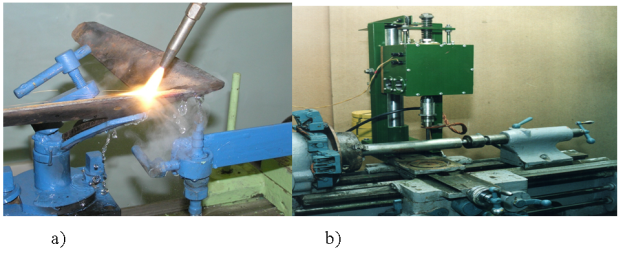
Fig. 2. Installation of electric pulse buildup — a) the process of gas-powder hardening of the cultivator's paw — b), [1, 2]
The second option for the organization of hardening of the working bodies of tillage machines is the strengthening of the paws of cultivators at machine-building enterprises, where this production is mass or serial. In this case, it is possible to use hardening methods using expensive high-performance equipment and using inexpensive consumables: laser, plasma and ion hardening, hardening using HDTV heating, electrocontact hardening with powder materials, electric arc hardening using robotic mechanisms.
The purpose of the study. Assessment of the possibility of strengthening the working part of the cultivator's paw by the electrocontact method, without the use of expensive additive materials.
Research methodology
For research, we took a cultivator's paw. A piece of arbitrary size was cut out with an angle grinder. It was not carried out on the lamp itself, because it is necessary to measure the hardness, and with the TK-14 hardness tester on the whole paw it is impossible to do this because of the size.
The hardness was measured on a hardness tester «Tochpribor» TK-14 (Figure 3), Before the measurements, the accuracy was checked on the standard measure of hardness GOST 9031. The measure had a hardness of 65HRC, on a hardness tester after 5 measurements, the result was 64 HRC. The error was -1 unit, so 1 was added to each measurement. Measurements were repeated 5 times to minimize the error. Also, after each quenching in different modes, the support surface was polished to remove the deflection of the sample during measurements.

Fig. 3. Hardness tester TK-14
After that, thermomechanical hardening was performed on the MT-1222 spot welding machine.(Figure 4)
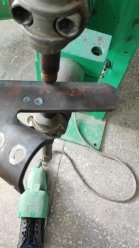
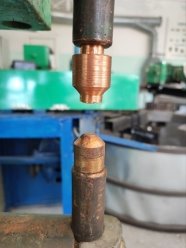
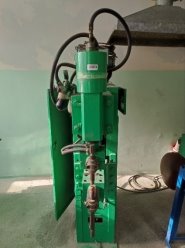
Fig. 4. Installation for spot welding MT-1222
To temper the paw, we made copper tips, the size was chosen based on the sharpened ends of the paw.
The necessary quenching mode (heating time and current) was selected by the selection method
To do this, the maximum current was set and the heating time was selected until the required temperature was reached, which was determined by the color of the steel at the heating site. The maximum current was chosen in order to minimize the heating time so as not to decarbonize the steel. They were also constantly cooled with water to obtain greater hardness.
To compare the steel method and the method of hardening in water, the same steel was tempered in water. Figure 6 shows the PET-4 muffle furnace that we used for this.
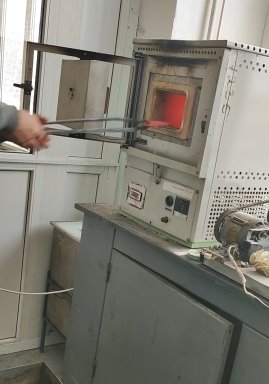
Fig. 6. Muffle furnace PET-4
The temperature and time parameters of heat treatment and the choice of its type depend on the initial structure of the steel. Steel 65G belongs to pre-eutectoid type steels, therefore, at temperatures above the lower point of austenitic transformation — 723 ° C — 30...50 ° C contains austenite in the form of a solid mechanical mixture with a small amount of ferrite. Since austenite is a harder structural component than ferrite, the quenching temperature range for 65G steel will be significantly lower than for structural steels with a lower percentage of carbon. Thus, the temperature range of hardening of steel of this brand should be within no more than 800... 830 ° C. The steel was heated to 830 degrees and sharply cooled in water, cleaned of scale and measured hardness
A thermal annealing process was carried out in the same furnace. To do this, the furnace was heated to a temperature of 830 degrees Celsius, after which it was turned off and a steel sample was placed in it. The sample was left in the oven until it cooled completely to room temperature. Carrying out this process was necessary for a more accurate determination of the carbon content in steel and an approximate determination of its grade. When quenching, steel in carbon content coincides with steel 40 or ST5, when quenching steel in carbon content, 65G can be compared. To determine the real brand, you need to do a spectral analysis
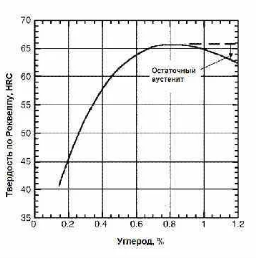
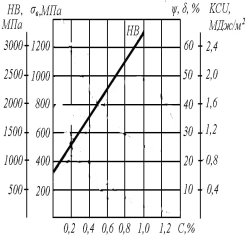
Fig. 7. Graphs for determining the amount of carbon depending on hardness
To determine the amount of carbon, we used the graphs in Figure 7, here shows the dependence of the amount of carbon on hardness for hardened and annealed steels.
Initially, the hardness of our steel averaged HRC15.4. After its quenching by the electrocontact method, the hardness increased to HRC 55–58. After quenching in water, we obtained an average hardness of HRC 59, which is commensurate with the hardness after applying the thermomechanical quenching method. After annealing, the hardness decreased to HRB88 (measured by Brinell, since the steel is too soft for Rockwell measurement, but theoretically it is 10HRC), which corresponds to the value of HB1790. From the graph, we found that the carbon content in this steel is 0.4...0.5 %. According to the brand, we assumed the nearest steel, which is steel 40 or St6 in terms of carbon content, and in terms of hardness — St5, although 65G steel should be used for the manufacture of paws.
Conclusion
Based on the data obtained, it can be concluded that this steel processing technique has the potential to achieve the desired hardness level above 55HRC after quenching. This result, in turn, can lead to an increase in the wear resistance of the paw and an improvement in the quality of tillage, which can lead to an increase in the resource of the paw. Thus, this technique can be considered as an effective way to optimize the production process of agricultural machinery. However, in order to fully assess the effectiveness of this technique, additional research and analysis of its impact on other production parameters are required.
References:
- RF Patent 2094187 Device for electropulse extension of worn surfaces of parts / Yudin N. S., 27.10.1997
- Fayurshin A. F. Technology of applying a wear-resistant layer to the blades of the working bodies of agricultural machines. Materials of the 41st scientific and technical conference of the Chelyabinsk State Agroengineering University — Chelyabinsk: CHGAU, 2002. — pp. 141–142.







